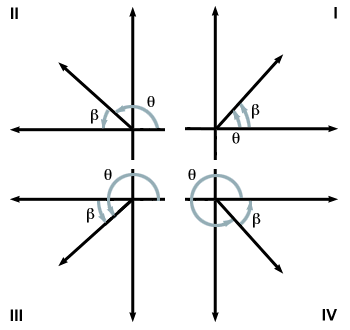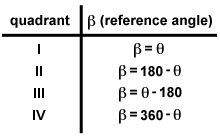Periodic Functions
Calculate sin( ) and sin(
) and sin( ) (using a calculator, for now).
The answer to both is
) (using a calculator, for now).
The answer to both is  . That is, the y-coordinate
of a point on the terminal side of these
angles is equal to one-half the distance between
the point and the origin. There are many cases in which
more than one angle has the same value for its sine, cosine, or some other
trigonometric function. This phenomenon exists because all trigonometric functions
are periodic. A periodic function is a function whose values (outputs) repeat
in regular intervals. Symbolically, a periodic function looks like this: f (x + c) = f (x),
for some constant c. The constant c is called the period--it is the interval at which
the function has a non-repeating pattern before repeating itself again. When we graph
the trigonometric functions, we'll see that the period of sine,
cosine, cosecant, and secant are 2Π, and the period of tangent and
cotangent is Π. For now, using reference angles, we'll learn how to calculate
the value of a trigonometric function of any angle just by knowing the value of the
trigonometric functions from 0 to
. That is, the y-coordinate
of a point on the terminal side of these
angles is equal to one-half the distance between
the point and the origin. There are many cases in which
more than one angle has the same value for its sine, cosine, or some other
trigonometric function. This phenomenon exists because all trigonometric functions
are periodic. A periodic function is a function whose values (outputs) repeat
in regular intervals. Symbolically, a periodic function looks like this: f (x + c) = f (x),
for some constant c. The constant c is called the period--it is the interval at which
the function has a non-repeating pattern before repeating itself again. When we graph
the trigonometric functions, we'll see that the period of sine,
cosine, cosecant, and secant are 2Π, and the period of tangent and
cotangent is Π. For now, using reference angles, we'll learn how to calculate
the value of a trigonometric function of any angle just by knowing the value of the
trigonometric functions from 0 to  .
.
Reference Angles
The use of reference angles is a way to simplify the calculation of the values of trigonometric functions at various angles. With a calculator, it is easy to calculate the value of any function at any angle. As you get more familiar with trigonometry, though, you'll memorize the values of a few simple trigonometric equations, and with reference angles, you can extend this knowledge of a few equations to many more.
A reference angle for a given angle in standard position
is the positive acute angle formed by the $x$-axis and the
terminal side of the given angle. Reference angles, by definition, always have a
measure between 0 and  . Due to the periodic nature of the trigonometric
functions, the value of a trigonometric function at a given angle is always the same as
its value at that angle's reference angle, except when there is a variation in sign.
Because we know the signs of the functions in different quadrants,
we can simplify the calculation of the value of a function at any angle to the value of
the function at the reference angle for that angle.
. Due to the periodic nature of the trigonometric
functions, the value of a trigonometric function at a given angle is always the same as
its value at that angle's reference angle, except when there is a variation in sign.
Because we know the signs of the functions in different quadrants,
we can simplify the calculation of the value of a function at any angle to the value of
the function at the reference angle for that angle.

For example, sin( ) = ±sin(
) = ±sin( ). We know this because the
angle
). We know this because the
angle  is the reference angle for
is the reference angle for  . Because we know
that the sine function is negative in the third quadrant, we know the whole answer:
sin(
. Because we know
that the sine function is negative in the third quadrant, we know the whole answer:
sin( ) = - sin(
) = - sin( ). Shortly, we will become very familiar
with expressions like sin(
). Shortly, we will become very familiar
with expressions like sin( ), and, without much thinking, we'll know
that the answer is
), and, without much thinking, we'll know
that the answer is  . Herein lies the usefulness of reference
angles: we only need to become familiar with the values of the functions from 0
to
. Herein lies the usefulness of reference
angles: we only need to become familiar with the values of the functions from 0
to  and the signs of the functions in each quadrant to be able
to calculate the value of a function at any angle.
and the signs of the functions in each quadrant to be able
to calculate the value of a function at any angle.
Below is a chart that will help in the easy calculation of reference angles. For angles in the first quadrant, the reference angle β is equal to the given angle θ. For angles in other quadrants, reference angles are calculated this way:

For angles greater than 2Π radians, simply subtract
2Π from them, and then use the chart above to calculate the accompanying
reference angle. When you become familiar with the values of certain
trigonometric functions at certain common angles, like  and
and
 , you will be capable of using reference angles to figure out
the values of these functions at an infinite number of other angles.
, you will be capable of using reference angles to figure out
the values of these functions at an infinite number of other angles.













